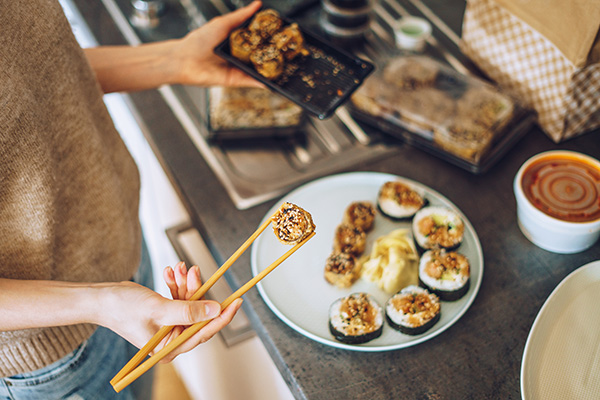Consumers continue to order restaurant food for off-premises consumption at a higher rate than they did before the pandemic, although operators still face some challenges when it comes to optimizing the takeout and delivery experience.
About 33 percent of foodservice-sourced meals were eaten at home before the pandemic, according to research from Datassential’s 2022 Food at Home Keynote report, compared to 44 percent of foodservice meals eaten at home this year.
“The pandemic totally changed things,” said Jack Li, co-founder and executive chairman of Datassential, during a recent webinar called discussing the report. “I don’t think we are going to go back to that 33 percent.”
The combination of consumers becoming accustomed to eating more restaurant meals off-premises, along with the trend toward working from home, are helping to drive ongoing takeout and delivery sales for restaurants, he said.
In addition, the fact that younger consumers have become so comfortable with mobile app-based ordering is also contributing to the off-premises dining trend, said Gerald Oksanen, research and insights manager at Datassential.
In fact, mobile apps have surpassed in-person ordering as the preferred ordering method for off-premises dining for all age groups other than Baby Boomers, who still prefer ordering in-person, by phone, or via website, rather than using a mobile app.
Among Gen Z and millennials, 62 percent and 65 percent, respectively, say they prefer using a mobile app. Among Gen X, 53 percent prefer using ordering via mobile app, and among Boomers, only 30 percent prefer using an app, vs. 62 percent who prefer to order in person.
Consumers also prefer using a restaurant’s own mobile app to that of a third party, Datassential found, with 74 percent of consumers saying they prefer using a restaurant’s app and 26 percent saying they prefer using a third-party app.
Restaurant operators have room for improvement when it comes to the app-based ordering experience, however.
The most common frustration that consumers have with app-based ordering is that there is no way to ask questions about the menu, cited by 34 percent of consumers, according to Datassential. Other top concerns included the entire menu not being available (cited by 29 percent of consumers), difficulty customizing orders (cited by 28 percent), and the inability to correct mistakes when placing an order (26 percent).
“Frustrations with app ordering really come down to a lack of customer support,” said Oksanen.
Concerns about Delivery
Both consumers and restaurant operators also have concerns about delivery. Consumers overwhelmingly rate the in-store experience as superior to delivery in almost every area, from the quality of the food to its affordability.
Restaurant operators, meanwhile, although they have relied significantly on third-party delivery platforms during the pandemic, also see several downsides, the Datassential report found. About four in five operators said the high fees and reduced profit margins associated with third-party delivery are a drawback. Combined with inflationary pressures on their cost of ingredients, the high costs associated with delivery might be leading many restaurants to eliminate that service, Li said.
“That’s why so many operators are just dropping third-party delivery and opting for less revenue in favor of better margins at the end of the day,” he said.
Operators also said they are concerned about their lack of control over the customer relationship, the experience their customers have interacting with delivery drivers, and the quality of the food upon arrival.
One of the benefits that operators have seen from the growth of off-premises dining is its ability to expand a restaurant’s reach, the Datassential report found. Nearly three-fourths of restaurants surveyed (74 percent) said their off-premises offerings have helped them reach new customers.
The report also highlighted the varying appeal of specific items when it comes to off-premises dining, using Datassential’s Scores research about the consumer appeal of new menu items. Only 37 percent of consumers said they were interested in ordering Crab and Lobster Fries from Glory Days Grill as a to-go or drive-thru item, for example, compared with 81 percent of consumers who said they would prefer to order Everything Stuffed Bagel Minis at Dunkin via take-out or drive-thru.
Interestingly, however, the report found that pizza has lost some its luster as a delivery item, perhaps because of the ubiquity of delivery across a broad range of food categories, Li said. The appeal of pizza delivery fell from 47 percent in 2020 to 40 percent in 2022, the report found.
Related: Uncle Giuseppe's Enables Catering Via Instacart; Surging Menu Items Reflect International Influence.

